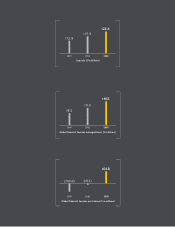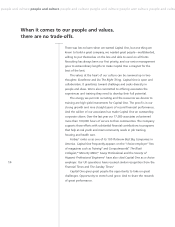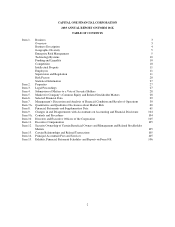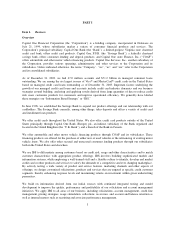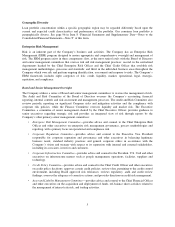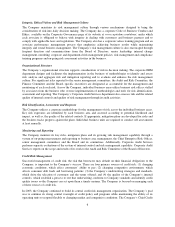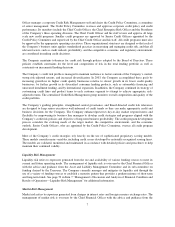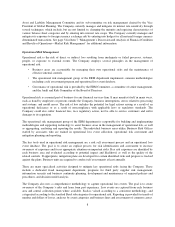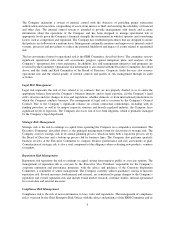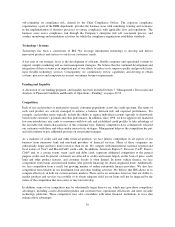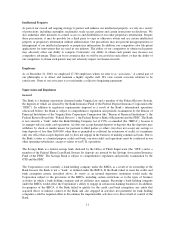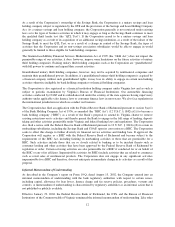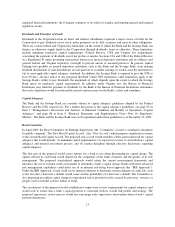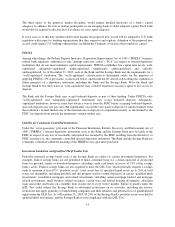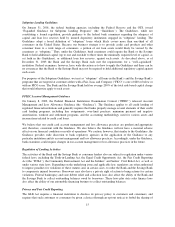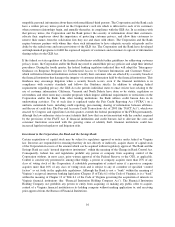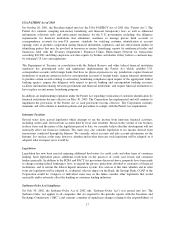Capital One 2003 Annual Report Download - page 25
Download and view the complete annual report
Please find page 25 of the 2003 Capital One annual report below. You can navigate through the pages in the report by either clicking on the pages listed below, or by using the keyword search tool below to find specific information within the annual report.Officer manages a corporate Credit Risk Management staff and chairs the Credit Policy Committee, a committee
of senior management. The Credit Policy Committee oversees and approves corporate credit policy and credit
performance. Its members include the Chief Credit Officer, the Chief Enterprise Risk Officer and the Presidents
of the Company’s three operating divisions. The Chief Credit Officer and his staff review and approve all large
scale new credit programs. Smaller credit programs are approved by Senior Credit Officers appointed by the
Credit Policy Committee and supervised by the Chief Credit Officer and his staff. All credit programs must also
be approved by the appropriate operating executives. These organizational structures are designed so that each of
the Company’s business units applies standardized practices in measuring and managing credit risk, and that all
relevant factors, such as credit outlook, profitability, and the competitive, economic, and regulatory environment,
areconsidered in making credit decisions.
The Company maintains tolerances for credit risk through policies adopted by the Board of Directors. These
policies establish constraints for the level and composition of risk in the total lending portfolio as well as
constraints on incremental lending decisions.
The Company’s credit risk profile is managed to maintain resilience to factors outside of the Company’s control,
strong risk-adjusted returns, and increased diversification. In 2003, the Company accomplished these goals by
increasing growth in its higher credit quality businesses relative to slower growth in its lower credit quality
businesses, by further growth in its diversified consumer lending products, such as automobile financing and
unsecured installment lending, and by international expansion. In addition, the Company continued its strategy of
customizing credit lines and product terms to each customer segment to attempt to achieve appropriate, risk-
adjusted returns. The centralized Credit Risk Management group monitors overall composition and quality of the
credit portfolio.
The Company’s guiding principles, strengthened central governance, and Board-directed credit risk tolerances
are designed to keep senior executives well-informed of credit trends so they can make appropriate credit and
business decisions for the Company. The Company enhances/preserves day-to-day market responsiveness and
flexibility by empowering its business line managers to develop credit strategies and programs aligned with the
Company’s credit risk policies and objective of long-term business profitability. The credit program development
process considers the evolving needs of the target market, the competitive environment, and the economic
outlook. Senior Credit Officers, who are appointed by the Credit Policy Committee, oversee all credit program
development.
Most of the Company’s credit strategies rely heavily on the use of sophisticated proprietary scoring models.
These models consider many variables, including credit scores developed by nationally recognized scoring firms.
The models are validated, monitored and maintained in accordance with detailed policies and procedures to help
maintain their continued validity.
Liquidity Risk Management
Liquidity risk refers to exposures generated from the use and availability of various funding sources to meet its
current and future operating needs. The management of liquidity risk is overseen by the Chief Financial Officer
with the advice and guidance from the Asset and Liability Management Committee and its sub-committee on
funding chaired by the Treasurer. The Company currently manages and mitigates its liquidity risk through the
use of a variety of funding sources to establish a maturity pattern that provides a prudent mixture of short-term
and long-term funds. See page 52 in Item 7 “Management’s Discussion and Analysis of Financial Condition and
Results of Operations—Liquidity Risk Management” for additional information.
Market Risk Management
Market risk refers to exposures generated from changes in interest rates and foreign currency exchange rates. The
management of market risk is overseen by the Chief Financial Officer with the advice and guidance from the
7


